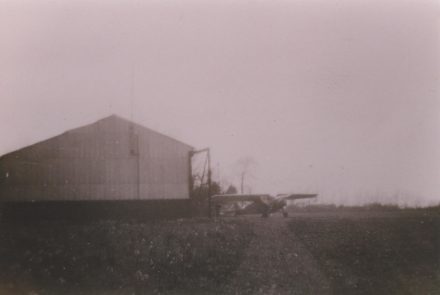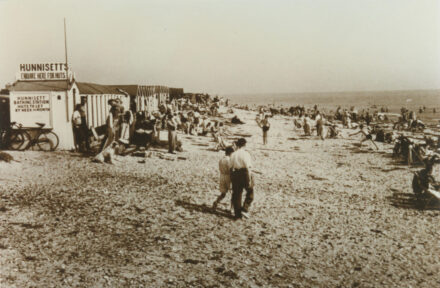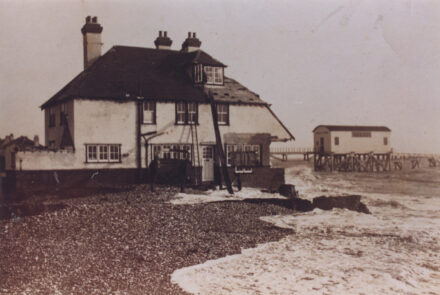STAINED GLASS WINDOWS
I’m sure we have all experienced the phenomenon of starting on a project only to find that, rather like Alice in Wonderland, the whole thing gives itself a shake and you find yourself on entirely another path. This was the case with the beautiful windows in St Peter’s Church.
The first thing we need to establish is that the window over the altar is referred to, in the records, as the east window while the one in the side aisle is referred to as being in the south side aisle. Those of us who are familiar with the history of the church will know that it faces north, not east, and the side aisle is, therefore, on the east side. Having cleared up this anomaly, I shall use the terms in the records for consistency’s sake.

Both windows were made by C E Kempe and Co. Ltd. Charles Eamer Kempe was born in Ovingdean, near Brighton, on 29 June 1837. A severe stammer prevented him from joining the priesthood so, according to Wikipedia, he said ‘if I was not permitted to minister in the Sanctuary I would use my talents to adorn it’. By the time of his death on 29 April 1907 his studio had produced over 3000 windows along with designs for altars, altar frontals, furniture, furnishings lych-gates and memorials. According to his biographer, Adrian Barlow, Kempe and his artists and craftsmen made the studios ‘the most sought-after in the later nineteenth century’ and are ‘now being acknowledged and revalued ‘. I also went to investigate Chichester Cathedral’s Kempe windows and drew a blank. I sent an email and received a reply from Carolyn who passed it on to one of the experts which states as follows:
There are two Kempe windows in Chichester Cathedral, one in the Mary Magdalene Chapel, the other in the Lady Chapel. There are two Kempe windows in the Cathedral. One is in the St Mary Magdalene Chapel at the eastern end of the South Choir Aisle; this window, as you found, has no wheatsheaf mark (for whatever reason). The other Kempe window is the tall three-light east window, high above the eastern side of the Retrochoir. Low down in the left- hand light of this window there is a wheatsheaf mark; but it is difficult to discern, even with binoculars, on account of the height of the window and a horizontal saddle bar which partly obscures it.

A large memorial to him, installed after his death, is in the south transept, close to the Information Desk.
The inscription reads: ‘ Remember ye in the Lord, Charles Eamer Kempe who in the constant dedication of his art to the adornment and Glory of God’s house served God in his generation, and departing this life the 29th day of April A.D.1907, was buried among others of his kin at Ovingdean, in the County of Sussex. His friends who honoured him in life and now mourn him in death have caused this tablet to be erected in the Cathedral Church of the holy Trinity Chichester, praying God to have mercy on his & all Xtian Souls.’


On this memorial we see the three wheatsheaves which form part of his armorial and which he adopted as his maker’s mark.
After his death and in accordance with his will, the studios were taken over by a relative, Walter Tower, and the maker’s mark was changed to indicate that the window was made by C E Kempe & Co.
The company was closed in 1934 as a result of the Great Depression.
Should you wish to know more about Charles Eamer Kempe and his work, Adrian Barlow has just published his biography ‘Kempe -The Life, Art and Legacy of Charles Eamer Kempe’, Lutterworth Press.
And now to the two windows in St Peter’s Church.

Perhaps rather controversially I will start with the side aisle window which is a memorial window to the parents and siblings of Fanny Farne Arnell Benstead, daughter of Henry Robinson Arnell, miller, and wife of Henry Benstead of whom you will learn more in future articles.
The tale started with the Commission Registers of C E Kempe & Co which show that on 7th April 1922 (Vol 7, p.90) window number 3088 was commissioned. This was somewhat confusing as ever since Edward Heron-Allen wrote the Guide to the Church, this window has been described as being installed in 1906. I contacted that fount of all knowledge, Tim McCann of the Heron-Allen Society, who came up trumps. He found ‘a nice little file in West Sussex Record Office under Selsey 1922 (Ep.I/40 bundle 3383)’ in the faculty records for Selsey which he urged me to peruse.
The bundle starts with a handwritten note (in appalling handwriting) giving the proposed site of the window, the subject (Faith, Hope and Charity) and the donor, Fanny. The cost was to be £240 and the supplier C E Kempe & Co, Ltd. The dedication was recorded. On 6th February 1872, the Selsey Parochial Church Council discussed the window and petitioned Winfrid, Bishop of Chichester applying for a faculty to install it. The Petition notes that the Diocesan Consultative Committee on Faculties had already approved the design. The petition was signed by the Incumbent, Rev. Mac and the two Churchwardens, Mr Ellis and one Henry Benstead, husband of Fanny Farne Arnell Benstead. On 27th February, the Rector, Kenneth Holland MacDermott (aka Rev. Mac), wrote, in his elegant handwriting, applying for a faculty for the window to be erected. He enclosed details and a sketch.
The sketch is very beautifully executed at a scale of ¾ inch = 1 foot. The window was to be 5 feet above the floor and depict, from left to right, Faith, Charity and Hope. And here I quote directly from Adrian Barlow’s email to me:
‘The three Virtues are each shown with the 6-pointed halo of light (always in a Kempe window this distinguishes a personification from an actual saint, who would have a conventional halo). The headdress of each woman is very 1920s, don’t you think? Half-way between a wedding veil (Charity) and a cloche hat (Hope). Faith holds a rather beautifully shaped and decorated shield and Hope holds the conventional anchor.
Charity, holding two children, is an unusual representation, which I have not seen before. In fact the cartoon for this image may well have been developed from earlier windows showing Christ himself holding a child in his arms. You’ll notice that Charity’s right hand is half raised in blessing. A Virtue would not usually have been represented thus. At the same time she is shown standing beneath a red damask canopy and in front of a cloth of honour. This is more usually how one might have expected the Virgin Mary to have been positioned. The whole pose is suggestive of the Madonna and Child.
The artist who designed this window was John William Lisle, who had been Kempe’s Chief Draughtsman and continued in this role until his death in 1927.
It’s not unusual for windows to be mistakenly dated according to the latest date mentioned on an inscription – as 1904 is mentioned on your inscription. I am sure this window cannot have been ordered in 1906.’
The Secretary of the Bishop of Chichester’s Diocesan Fund wrote to Rev. Mac. On 19th April 1922 returning the design and stating it ‘has been approved by the Advisory Committee’. Rev. Mac. then wrote to the Bishop’s Registrar telling him of the approval and asking for the faculty. He also confirmed the design had been approved by Selsey PCC.
On the 9th June G Ashley Tyacke, the Notary Public, Diocesan Registrar and Bishop’s Secretary (Tel. No. 73) wrote to Mr Chancellor, who was the Worshipful Kenneth MacMorran MA. LLB, asking for his approval of the proposal. On the 15th June the Incumbent and the two Churchwardens certified that the notice regarding the Petition ‘was affixed to the Principal Door of the said Church on the 15th day of June and remained so affixed until this 25th day of June 1922.’
And, finally, the window was installed on 4 June 1922 which was Whit Sunday.

And now we turn our attention to the Jewell Window.

On 21st August 1916 Ada M Pugh Cook, mother of Dudley Mark Hayward Jewell and Edward Herbert Jewell, wrote to Rev. Mac as follows:
‘Maurice tells me he spoke to you this morning with regard to the enclosed sketch which we all like very much. Please ask to have the Badges of Royal Fusiliers and Lancashire Fusiliers placed somewhere on the window, they will easily procure these. With Kindest regards and looking forward to seeing you next Saturday, yours sincerely…’
On 14th September, Rev Mac wrote to Mr. Freeland asking for a Faculty for the window. This window cost £180, including fixing. ‘The subjects of the window are: centre light the Risen Christ; left light St Peter; right St. George. It is approved by the Bishop.’ He wrote again on the 27th September sending a copy of the Minute in the Minute-book of the Selsey Vestry relating to the Stained-glass window and the design of the window which, sadly, does not appear to have survived.
The Vestry had met on the 25th September and consisted of Rev. Mac. Mr Ellis churchwarden, Messrs. S Dewey, F Barnes, J Lawrence, J Sherrington, H Whittenstall and W Shepherd. They recorded all the details of the window as they were to do later in 1922.
Mr Freeland received a missive from the Bishop’s Registry dated 6th October confirming that the memorial of the brothers Jewell was ‘quite in order’ .
Once again, we return to Adrian Barlow for his views on the window. We do have the design record from C E Kempe & Co and we can see that the window number is 2650.

‘Here is the entry for this window, from the Commission Register, vol. 6, p.161, dated Nov 18 1916. One small detail: the inscription for St Peter’s book . ’Thou art the Christ, the son of the Living God’ actually appears in Latin, not English, in the finished window; otherwise everything else is as indicated in the drawing. The word ’Sketch’ in the bottom left-hand corner means that the donor(s) of the window were sent a miniature sketch at this stage, or earlier, on the basis of which they will have agreed to go ahead with the window. One of the most interesting features of the window is the ‘Charge to Peter’ – the small scene at the bottom of the centre light. I don’t think I have seen this depiction in a Kempe window before, and it is rather charming with the boat in the distance on the Lake of Galilee .
Usually in such scenes, Christ is shown cooking the fish over a small fire; but here breakfast is still in the bucket. The theme of the window is, in a way, Resurrection, a reassuring topic for a war memorial window. I shall certainly bear this window in mind as a war memorial erected while the war was still in progress – hardly surprising, though, since the Jewell’s had lost two sons in less than four months.’
Adrian also added the following comment in a separate document:
‘I’m not a freemason – and neither was Kempe, as far as I can discover – but I wonder whether the clasp holding together the outer robe worn by Christ displays a masonic symbol: the circle within a square. Other masonic symbols occasionally appear in the same place in Kempe windows.
I also wonder whether the face of St George might possibly be a portrait of one of the dead Jewell sons. It is finely drawn and more individualised than a lot of John Lisle’s faces.’
The Petition was duly sent to the Right Reverend Father in God Charles John, Lord Bishop of Chichester praying that a faculty be granted. It was signed by Rev. Mac, William Charles Ellis and Henry Benstead. The Notice was affixed to the door of the church on 10th of October and remained affixed until the 20th of October 1916. Again, Rev. Mac and Henry Benstead signed the document. The Faculty was granted on 23rd October.
On 27th October 1916, Rev. Mac sent a bill to Mr W B B Freeland who, we now discover, was the Diocesan Registrar and Bishop’s Secretary. ‘To fee for Faculty authorising and empowering Mrs Pugh-Cook of Selsey to insert a Stained Glass Window to the memory of her two Sons, the late Lieuts. D M H and E H Jewell.
To fee to Chancellor £1 1s 0d, To Fee to Registrar £1 1s 0d. Mr Freeland duly endorsed it ‘Received with thanks’ and returned it. The most charming addition is a note from Rev. Mac to Mr Freeland enclosing £2. 2s 0d but asking ‘Is any fee due to me as Rector and owner of chancel for erection of this window? There is nothing about windows in my List of Fees.’ What a pity we have no reply!
The Chichester Observer of 24th January, 1917duly reported the dedication of the window on 20th January of that year:
‘The window was unveiled by Major Jewell, a brother of the deceased officers, in the presence of a large congregation, and the dedicatory prayers were read by the Rev. Prebendary C G Wilson, Vicar of Cuckfield, a former Rector of Selsey…The window… has been executed by Messrs C E Kempe, of London, and has been greatly admired by those who have seen it. In the central light the subject is the Risen Lord, with a background of the Sea of Galilee with fishing smacks – an appropriate setting, not only descriptive of the subject but also of the village of Selsey…The window will be seen to full advantage in brighter weather; on Saturday it was very gloomy.’
I was fascinated with what I discovered about two of our church windows. Space precludes me from including the others. I do hope you find the wheatsheaf and black tower!
Ruth C Mariner
This article is the intellectual property of the author and may not be copied or used in any way without her written permission.
Acknowledgements are due to:
Tim McCann for his unfailing and generous support
Adrian Barlow and the Kempe Trust for coming a close second in the above.
Chichester and Bognor Regis Observer David Philip on behalf of Copydesk Sussex
West Sussex Record Office for rooting out the bundle for me and for copying its contents Chichester Cathedral’s anonymous expert for the succinct explanation



